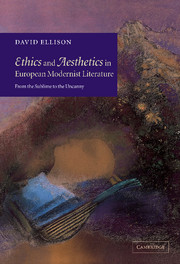EPILOGUE: Narrative and music in Kafka and Blanchot: the “singing” of Josefine
Published online by Cambridge University Press: 22 September 2009
Summary
The historical trajectory I have traced thus far, which leads from the Kantian sublime to Modernist textual elaborations of Unheimlichkeit, tells the story of the difficult points of intersection between aesthetic theory and practice, on the one hand, and ethical complexity and danger, on the other. If there is common ground between the sublime and the uncanny, it is that both are depicted, by philosophers and writers, as unsettling experiences in which the individual human subject, having set out to plot the territory of beautiful forms, encounters, within these forms, the moral labyrinth on which they are constructed. The various strategies of containment and envelopment whereby the aesthetic and the ethical alternately negate and destroy each other's pretension to dominance have been at the center of this book, from Kant to Woolf.
If I have decided to end the chronological survey of my study with Woolf, it is because, in my view, her encounter with the dispossessive energy of Unheimlichkeit structured not only her intimate psychological struggles, but also her literary production. Woolf's fall into impersonality is, in and of itself, a fall into the fundamental unhomeliness of literature, of the literary as such. Yet it would be a simplification, I think, to conclude that the only mode of encounter with the uncanny-as-literature is that of fear and anxiety, whereby the individual subject, having lost her bearings in a world of blurred boundaries, succumbs to madness and death.
- Type
- Chapter
- Information
- Ethics and Aesthetics in European Modernist LiteratureFrom the Sublime to the Uncanny, pp. 211 - 230Publisher: Cambridge University PressPrint publication year: 2001



